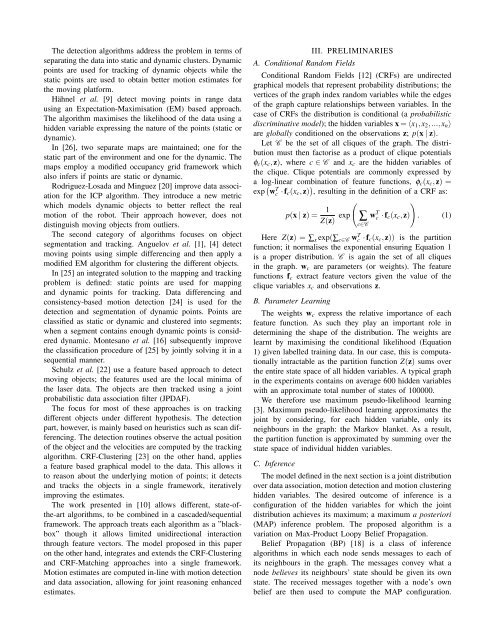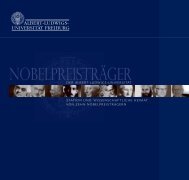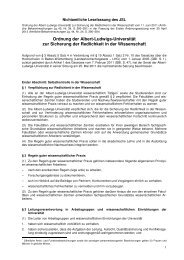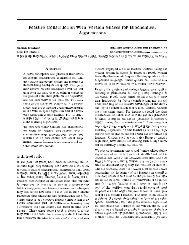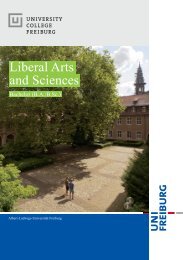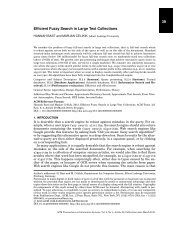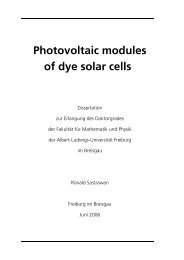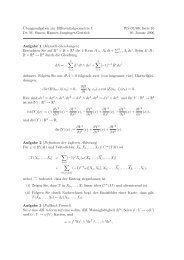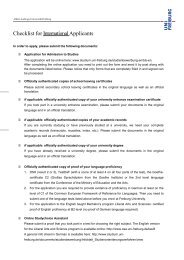An Integrated Probabilistic Model for Scan-Matching, Moving Object ...
An Integrated Probabilistic Model for Scan-Matching, Moving Object ...
An Integrated Probabilistic Model for Scan-Matching, Moving Object ...
You also want an ePaper? Increase the reach of your titles
YUMPU automatically turns print PDFs into web optimized ePapers that Google loves.
The detection algorithms address the problem in terms ofseparating the data into static and dynamic clusters. Dynamicpoints are used <strong>for</strong> tracking of dynamic objects while thestatic points are used to obtain better motion estimates <strong>for</strong>the moving plat<strong>for</strong>m.Hähnel et al. [9] detect moving points in range datausing an Expectation-Maximisation (EM) based approach.The algorithm maximises the likelihood of the data using ahidden variable expressing the nature of the points (static ordynamic).In [26], two separate maps are maintained; one <strong>for</strong> thestatic part of the environment and one <strong>for</strong> the dynamic. Themaps employ a modified occupancy grid framework whichalso infers if points are static or dynamic.Rodriguez-Losada and Minguez [20] improve data association<strong>for</strong> the ICP algorithm. They introduce a new metricwhich models dynamic objects to better reflect the realmotion of the robot. Their approach however, does notdistinguish moving objects from outliers.The second category of algorithms focuses on objectsegmentation and tracking. <strong>An</strong>guelov et al. [1], [4] detectmoving points using simple differencing and then apply amodified EM algorithm <strong>for</strong> clustering the different objects.In [25] an integrated solution to the mapping and trackingproblem is defined: static points are used <strong>for</strong> mappingand dynamic points <strong>for</strong> tracking. Data differencing andconsistency-based motion detection [24] is used <strong>for</strong> thedetection and segmentation of dynamic points. Points areclassified as static or dynamic and clustered into segments;when a segment contains enough dynamic points is considereddynamic. Montesano et al. [16] subsequently improvethe classification procedure of [25] by jointly solving it in asequential manner.Schulz et al. [22] use a feature based approach to detectmoving objects; the features used are the local minima ofthe laser data. The objects are then tracked using a jointprobabilistic data association filter (JPDAF).The focus <strong>for</strong> most of these approaches is on trackingdifferent objects under different hypothesis. The detectionpart, however, is mainly based on heuristics such as scan differencing.The detection routines observe the actual positionof the object and the velocities are computed by the trackingalgorithm. CRF-Clustering [23] on the other hand, appliesa feature based graphical model to the data. This allows itto reason about the underlying motion of points; it detectsand tracks the objects in a single framework, iterativelyimproving the estimates.The work presented in [10] allows different, state-ofthe-artalgorithms, to be combined in a cascaded/sequentialframework. The approach treats each algorithm as a ”blackbox”though it allows limited unidirectional interactionthrough feature vectors. The model proposed in this paperon the other hand, integrates and extends the CRF-Clusteringand CRF-<strong>Matching</strong> approaches into a single framework.Motion estimates are computed in-line with motion detectionand data association, allowing <strong>for</strong> joint reasoning enhancedestimates.III. PRELIMINARIESA. Conditional Random FieldsConditional Random Fields [12] (CRFs) are undirectedgraphical models that represent probability distributions; thevertices of the graph index random variables while the edgesof the graph capture relationships between variables. In thecase of CRFs the distribution is conditional (a probabilisticdiscriminative model); the hidden variables x = 〈x 1 ,x 2 ,...,x n 〉are globally conditioned on the observations z; p(x | z).Let C be the set of all cliques of the graph. The distributionmust then factorise as a product of clique potentialsφ c (x c ,z), where c ∈ C and x c are the hidden variables ofthe clique. Clique potentials are commonly expressed bya log-linear combination of feature functions, φ c (x c ,z) =exp ( w T c · f c (x c ,z) ) , resulting in the definition of a CRF as:(p(x | z) = 1Z(z) exp ∑ w T c · f c (x c ,z)c∈C). (1)Here Z(z) = ∑ x exp(∑ c∈C w T c · f c (x c ,z)) is the partitionfunction; it normalises the exponential ensuring Equation 1is a proper distribution. C is again the set of all cliquesin the graph. w c are parameters (or weights). The featurefunctions f c extract feature vectors given the value of theclique variables x c and observations z.B. Parameter LearningThe weights w c express the relative importance of eachfeature function. As such they play an important role indetermining the shape of the distribution. The weights arelearnt by maximising the conditional likelihood (Equation1) given labelled training data. In our case, this is computationallyintractable as the partition function Z(z) sums overthe entire state space of all hidden variables. A typical graphin the experiments contains on average 600 hidden variableswith an approximate total number of states of 100000.We there<strong>for</strong>e use maximum pseudo-likelihood learning[3]. Maximum pseudo-likelihood learning approximates thejoint by considering, <strong>for</strong> each hidden variable, only itsneighbours in the graph: the Markov blanket. As a result,the partition function is approximated by summing over thestate space of individual hidden variables.C. InferenceThe model defined in the next section is a joint distributionover data association, motion detection and motion clusteringhidden variables. The desired outcome of inference is aconfiguration of the hidden variables <strong>for</strong> which the jointdistribution achieves its maximum; a maximum a posteriori(MAP) inference problem. The proposed algorithm is avariation on Max-Product Loopy Belief Propagation.Belief Propagation (BP) [18] is a class of inferencealgorithms in which each node sends messages to each ofits neighbours in the graph. The messages convey what anode believes its neighbours’ state should be given its ownstate. The received messages together with a node’s ownbelief are then used to compute the MAP configuration.


